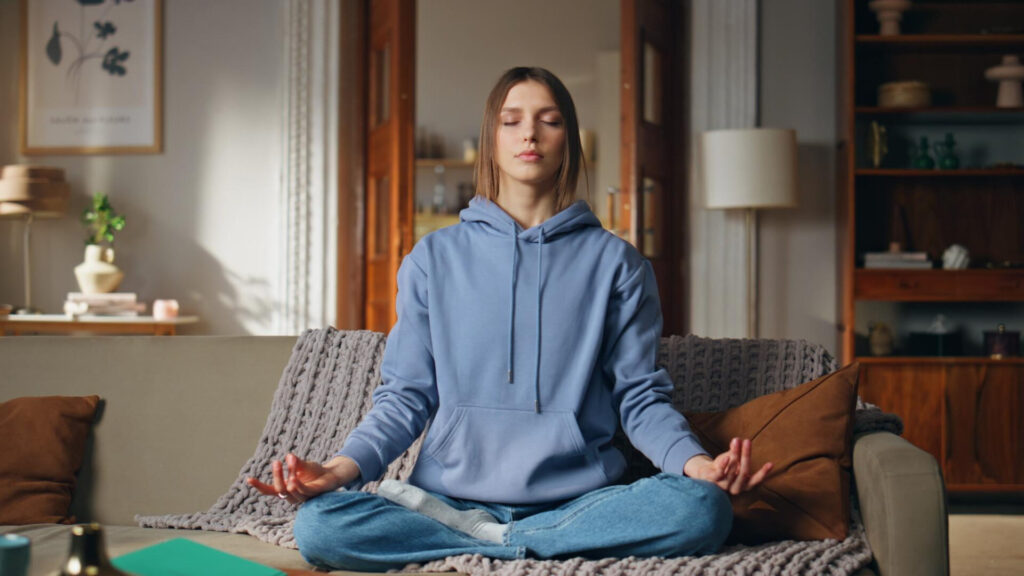Why Guided Visualization is Perfect for Beginners
A Simple Path to Mindfulness 🧘
Stepping into mindfulness can feel daunting, especially with countless meditation exercises and complex practices to choose from. Guided visualization for beginners simplifies this journey, providing a structured yet gentle approach to relaxation and self-awareness. By harnessing your imagination through guided imagery meditation, you effortlessly tap into mindfulness, clarity, and emotional calmness—even if meditation hasn’t felt accessible before.
What Makes Visualization Unique? 🌟
Visualization isn’t about forcing your mind into silence; it’s about directing your imagination to meaningful and calming imagery. This method sets it apart from traditional meditation exercises by:
✔️ Reducing Anxiety Quickly – Guided scenarios create safe mental spaces, helping beginners easily visualize relaxation.
✔️ Enhancing Emotional Balance – Structured imagery helps regulate emotions, fostering a deep sense of inner calm.
✔️ Improving Mental Clarity – Regular practice trains your mind to stay clear and focused, even amid distractions.
Ready to Start Your Journey? 🚀
Whether your goal is stress relief, better sleep, or simply greater emotional peace, visualization for relaxation is an ideal entry point. No prior experience is needed—just a willingness to explore your own mind through guided imagery.
“Your imagination is your greatest tool. Let it guide you toward calmness, clarity, and personal growth.”
Below, you’ll explore exactly how guided visualization works, discover its scientific basis, and get practical steps to effortlessly integrate it into your daily life.

The Science Behind Guided Visualization
How Visualization Affects the Brain
Guided visualization is more than just imagination—it has measurable effects on brain activity. When you visualize an event or experience, your brain activates the same neural pathways as if you were actually experiencing it.
🔬 Neuroscientific studies using fMRI scans have shown that mental imagery can stimulate the same regions of the brain involved in real-life movement, emotions, and sensory perception. This means that by visualizing success, relaxation, or healing, you can train your brain to respond as if those outcomes were already happening.
For example, athletes use mental rehearsal to enhance their performance. Studies show that simply visualizing an action—like shooting a basketball—can improve accuracy and muscle coordination almost as effectively as physical practice.
Psychological and Emotional Impact
Guided visualization influences emotions and mental states in several key ways:
🧠 Activates the Parasympathetic Nervous System – Induces relaxation by lowering heart rate and cortisol levels.
💭 Strengthens Positive Thinking Patterns – Rewires neural pathways to reinforce optimism and resilience.
😌 Reduces Fear and Anxiety – By visualizing calming or empowering scenarios, the brain learns to respond with less fear in real situations.
Scientific Studies on Visualization
Several research studies confirm the effectiveness of guided visualization:
| Study | Findings |
|---|---|
| Harvard Medical School (1995) | Mental practice alone improved finger muscle strength by 22% (compared to 30% in those who physically trained). |
| Cleveland Clinic (2004) | Patients using visualization techniques during recovery from surgery experienced less pain and faster healing. |
| Journal of Sports Science (2017) | Athletes who practiced mental imagery performed better under pressure than those who only relied on physical training. |
This scientific backing makes guided visualization a legitimate and powerful tool—not just for relaxation, but also for mental conditioning, pain management, and personal development.
Getting Started with Guided Visualization
Setting the Right Environment
Creating an ideal environment enhances the effectiveness of guided visualization. While this practice can be done anywhere, a calm and distraction-free space improves focus and immersion.
✔️ Find a quiet place – Avoid noisy areas where interruptions are likely.
✔️ Use comfortable seating or lying positions – A relaxed body supports a relaxed mind.
✔️ Adjust lighting – Dim lighting or natural light can help create a soothing atmosphere.
✔️ Incorporate gentle background sounds – Soft music or nature sounds can deepen relaxation.
Many practitioners also find that using essential oils (like lavender for relaxation or peppermint for focus) or lighting a candle enhances the experience.
Choosing the Right Guidance (Apps, Audio, or Live Sessions)
Guided visualization can be self-led or assisted by external resources. The best choice depends on personal preference and learning style.
Popular options include:
🟢 Guided Audio Recordings – Available on platforms like YouTube, Insight Timer, and Calm. Best for those who prefer a structured experience.
🟢 Meditation & Mindfulness Apps – Apps like Headspace and BetterSleep offer high-quality guided sessions.
🟢 Live Sessions with Instructors – Yoga studios and mindfulness coaches often provide personalized guidance.
🟢 Self-Guided Practice – Ideal for those who prefer to create their own mental images and narratives.
Experimenting with different formats helps identify what works best for your mind and lifestyle.
Common Misconceptions and How to Overcome Them
Many beginners hesitate to try guided visualization due to common misunderstandings:
❌ “I can’t visualize clearly, so it won’t work.”
✔️ Visualization is not about seeing perfect images—it’s about engaging your senses (feeling, hearing, even imagining scents and textures).
❌ “It takes too much time.”
✔️ Even 5–10 minutes can have significant benefits. Short sessions can be just as effective as long ones.
❌ “You have to be good at meditation to do this.”
✔️ Unlike traditional meditation, visualization is active and engaging, making it easier for those who struggle with emptying their minds.
By clearing up these misconceptions, beginners can approach visualization with confidence and openness.

Types of Guided Visualizations
Guided visualization can serve different purposes, depending on the desired outcome. Whether you want to reduce stress, boost confidence, or improve sleep, there is a specific type of visualization to support your goal.
Relaxation and Stress Reduction Visualizations
These visualizations help calm the nervous system and reduce anxiety by guiding the mind into a peaceful state.
✅ Example: Imagining yourself lying on a warm beach, feeling the sun on your skin and listening to the rhythmic waves.
✅ Best for: Overcoming daily stress, managing anxiety, and unwinding after a long day.
Confidence and Self-Empowerment Visualizations
Designed to enhance self-esteem and motivation, these visualizations focus on positive self-perception and mental rehearsal of success.
✅ Example: Visualizing yourself giving a powerful speech with confidence, receiving applause, and feeling proud of your performance.
✅ Best for: Public speaking, career advancement, and overcoming self-doubt.
Sleep and Deep Rest Visualizations
These sessions guide the mind into a state of deep relaxation, making it easier to fall asleep and stay asleep.
✅ Example: Mentally walking through a peaceful nighttime forest, hearing crickets and feeling a cool breeze as your body becomes heavier.
✅ Best for: Insomnia, restless nights, and improving overall sleep quality.
Healing and Pain Relief Visualizations
Used in holistic healing and medical recovery, these visualizations help the body’s natural healing processes. Studies suggest that mental imagery can reduce pain perception and promote faster recovery.
✅ Example: Imagining a warm golden light traveling through your body, gently healing pain points and restoring energy.
✅ Best for: Chronic pain, post-surgery recovery, and emotional healing.
Goal-Oriented Visualizations (Success, Career, Relationships)
Many high performers use visualization to mentally prepare for success before it happens. This technique aligns the subconscious mind with desired outcomes.
✅ Example: Seeing yourself achieving a major life goal—getting a promotion, winning a competition, or having a fulfilling relationship.
✅ Best for: Career growth, achieving personal goals, and reinforcing positive habits.
Each type of guided visualization activates different areas of the brain, but they all share a common principle: what the mind consistently envisions, the body and emotions follow.
Step-by-Step Guide to Your First Guided Visualization
Starting guided visualization for the first time may feel unfamiliar, but by following a structured approach, you can make it a powerful and effective practice.
1. Find a Comfortable Position
Your physical comfort plays a major role in how deeply you can immerse yourself in visualization.
✔️ Sitting or lying down – Choose a position where you won’t feel tension or discomfort.
✔️ Support your body – Use cushions, a yoga mat, or a comfortable chair to maintain relaxation.
✔️ Close your eyes (if comfortable) – This helps block distractions and enhances focus.
2. Use Breathing Techniques for Deeper Immersion
Before beginning the visualization, engage in slow and deep breathing to activate relaxation responses in the brain.
💨 Simple breathing technique:
- Inhale deeply through the nose for 4 seconds.
- Hold the breath for 4 seconds.
- Exhale slowly through the mouth for 6 seconds.
- Repeat 4–5 times to enter a relaxed state.
Deep breathing reduces stress hormones, making it easier to engage with visualization exercises.
3. Follow the Narrative and Engage Your Senses
Whether using a guided audio track or self-directing your visualization, fully immerse yourself in the mental imagery by activating different senses:
👀 Visual – Picture colors, objects, landscapes.
👂 Auditory – Imagine sounds like waves, wind, or voices.
🖐️ Tactile – Feel textures, temperatures, or movements.
👃 Olfactory – Smell the scent of flowers, food, or fresh air.
👅 Gustatory – Imagine tasting a favorite meal or a sip of tea.
The more senses you involve, the more vivid and powerful the experience becomes.
4. Let Go of Distractions
During your first sessions, random thoughts may pop up. Instead of fighting them, gently redirect your focus to the visualization.
❌ What to avoid:
- Overanalyzing details (“Am I imagining this correctly?”).
- Trying to control the outcome instead of allowing the imagery to flow.
- Getting frustrated if thoughts wander—this is normal!
✔️ Tip: If distractions persist, repeat a simple anchor phrase (e.g., “I am calm and focused”) to bring your attention back.
5. End with a Gentle Transition
After finishing your visualization, avoid rushing back to daily tasks. Instead:
🔹 Take a few deep breaths and stretch gently.
🔹 Reflect on how the visualization made you feel.
🔹 Carry that feeling with you into your next activities.
By practicing regularly, your mind will naturally strengthen its ability to visualize clearly and access the benefits more quickly.
References and Inspirational Resources
- Kabat-Zinn, Jon. Wherever You Go, There You Are: Mindfulness Meditation in Everyday Life. Hyperion.
- Davidson, Richard J. & Begley, Sharon. The Emotional Life of Your Brain: How Its Unique Patterns Affect the Way You Think, Feel, and Live—and How You Can Change Them. Penguin.
- Journal of Sports Sciences – Studies on the impact of visualization and mental rehearsal in athletic performance.
- Harvard Medical School – Research on neuroplasticity and the effects of mental imagery on the brain.
- Psychology Today – Articles on mindfulness, guided imagery, and stress reduction techniques.
- Cleveland Clinic – Clinical insights on visualization for pain management and post-surgical recovery.
- Headspace – Practical guided visualization and meditation tools for beginners.















